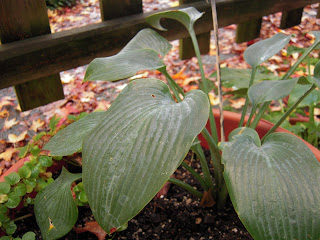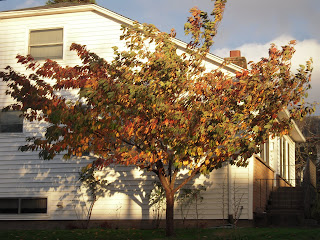SUN vs. SHADE
Sun Loving Japanese Bloodgrass
We have learned that the sun meter on plant tags help the gardener place plants in the appropriate spot (in Project 2: Making Sense of Plant Tags) but what is it that really distinguishes sun plants from shade plants?
Photosynthesis
All plants need some sunlight to survive (generally along with water, soil, and insects for prosperity). Energy from the sun is absorbed and held in the leaves by their green pigment (chlorophyll). This energy is then used to convert carbon dioxide (and water) into food for the plant. Oxygen is then released from the plant as the final step in the photosynthesis process. whew!
For a more in depth look at plant biology, check out Kingsly R. Stern's Introductory Plant Biology. It's a textbook but a nice read nonetheless!
Shade Loving Hosta
Sun Loving, Shade Loving, and Somewhere In Between
Sun loving plants are those that can handle full sun in their photosynthesis process. Their leaves are often thicker and smaller than shade loving plants and the cellular makeup is different. They are built to make the most of their frequent exposure to the sun. Shade loving plants, alternately are often thin and large. This allows them to gain maximum exposure to the sun when it hits them. They also tend to have more chlorophyll for the same reason. If a shade loving plant is placed in direct sun it will likely burn because it is designed to be more sensitive. Plants may be hardwired specifically for full sun, partial shade and full shade but some (like trees) have leaves that are built to survive in all three. The differences between a sun and shade loving leaf can also be seen in one plant when the higher leaves (sun loving) cover lower leaves (which in turn become shade loving). you still with me?
Sun Loving Yard/Shade Loving Yard
A quick walk around the neighborhood can give you a good sense of which plants love sun and which love shade. It's even easier in a city where urban planners have planned the streets on grid that is lined up with the points on a compass. In this case, simply walk east-west and look to your left and right--you should immediately see the sunny plants on the southern side and the darker shade plants on the northern side.
It is a good idea to have a solid understanding of the sun exposure in your garden before planning your plot. You can either check it every hour of the day (1 time per season) and sketch a sun map of your plot or to save some time and trouble, seek the help of landscape architecture firms which often have data such as this for building purposes.
It is a good idea to have a solid understanding of the sun exposure in your garden before planning your plot. You can either check it every hour of the day (1 time per season) and sketch a sun map of your plot or to save some time and trouble, seek the help of landscape architecture firms which often have data such as this for building purposes.
Once that's settled, there are many books and website devoted to helping gardeners find the right plant for the right spot.








Great info! Being in a desert climate, many of the plants that are native have tiny leaves in order to minimize transpiration. The spines of a cactus serve to shade the cactus as well. It is amazing how plants have adapted to particular climates.
ReplyDeleteThanks for a great post!
Wow...Japanese Bloodgrass on your blog looks wonderful. I have never seen anything like it.
ReplyDeleteLove your name -Hortus Urbanus! Glad to have found your blog. Great informative post.
ReplyDeleteVery informative - enjoyed reading it. Found you through Blotanical incidentally.
ReplyDeleteI have found in my gardening experience that sometimes the plant has ideas that contradict the tag. I have shade plants that grow well in the sun and sun plants that do fine in the shade. As easy as plants can be to move, I like to experiment.
ReplyDeleteYes the sun vs. shade question. Having a garden that is shaded in the morning and gets hot afternoon sun in various spots does challenge me. Good post.
ReplyDeleteSarah,
ReplyDeleteGreat to find you on Blotanical! Will look forward to your musings, and to the public spaces you choose to highlight.
Cheers, Alice
aka Bay Area Tendrils Garden Travel